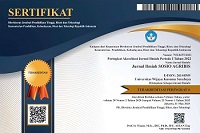Penerapan Metode Regresi Least Absolute Shrinkage and Selection Operator (LASSO) dan Regresi Linier untuk Memprediksi Tingkat Kemiskinan di Indonesia
Abstract
Poverty is defined as a situation where a person or family is unable to meet the basic needs for survival, such as clothing, food, shelter, and education. This study aims to compare the accuracy of the Least Absolute Shrinkage and Selection Operator (Lasso) regression method and linear regression in predicting poverty levels in Indonesia and to choose the best model from the two methods used. The results of this study indicate that of the two algorithms used, namely the linear regression algorithm and Lasso regression, the algorithm that has a higher level of accuracy for predicting poverty rates in each province in Indonesia is the linear regression algorithm because it has a lower MSE value and has the value of R^2 is closer to 1 than the Lasso regression algorithm. In addition, the results of the analysis show that the variables that have the highest influence on poverty rates in provinces in Indonesia are education, as well as the Human Development Index (IPM).
Keywords: Poverty Rate Prediction, Lasso Regression, Linear Regression
Full Text:
PDFDOI: http://dx.doi.org/10.30742/jisa22220222620
Refbacks
- There are currently no refbacks.
Copyright (c) 2023 Eka Rossalina Fitria

This work is licensed under a Creative Commons Attribution-ShareAlike 4.0 International License.






